HUM200 Cultural Artifact Essay
VerifiedAdded on 2019/09/20
|11
|1815
|182
Essay
AI Summary
This essay delves into the study of cultural artifacts, specifically focusing on the role of music and art in representing the history and experiences of diverse communities. It examines the historical context of music, highlighting the evolution of musical forms and instruments across different periods. The essay also explores the personal experiences of the author and the professional insights of Dr. Wintz, a specialist in the Harlem Renaissance. Furthermore, it discusses the similarities and differences in how various cultures utilize musical instruments and the symbolic meanings embedded within them. The essay concludes by emphasizing the importance of studying artifacts to understand musical knowledge and cultural heritage, aiming to connect with an audience interested in national identity and the power of music and art.
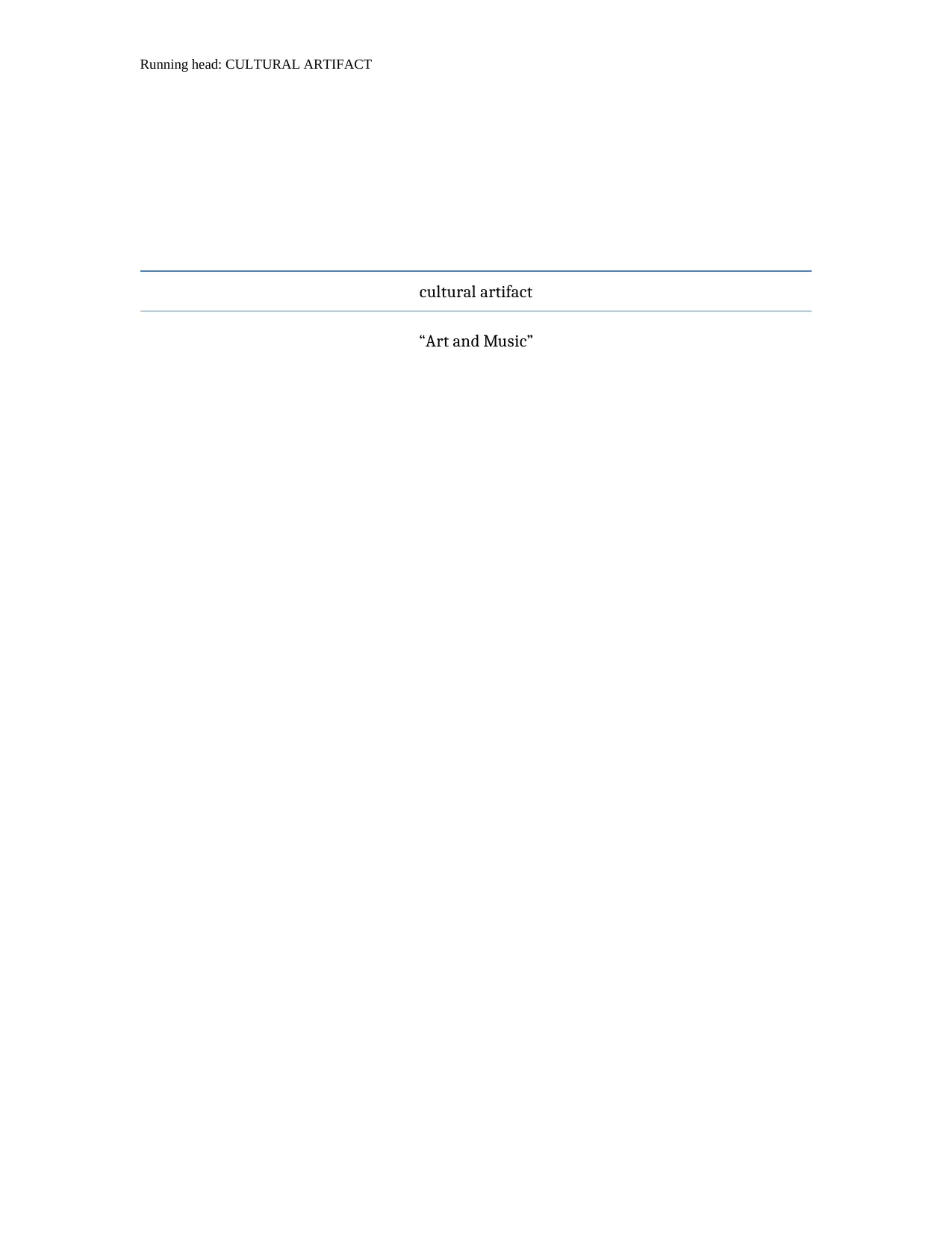
Running head: CULTURAL ARTIFACT
cultural artifact
“Art and Music”
cultural artifact
“Art and Music”
Paraphrase This Document
Need a fresh take? Get an instant paraphrase of this document with our AI Paraphraser
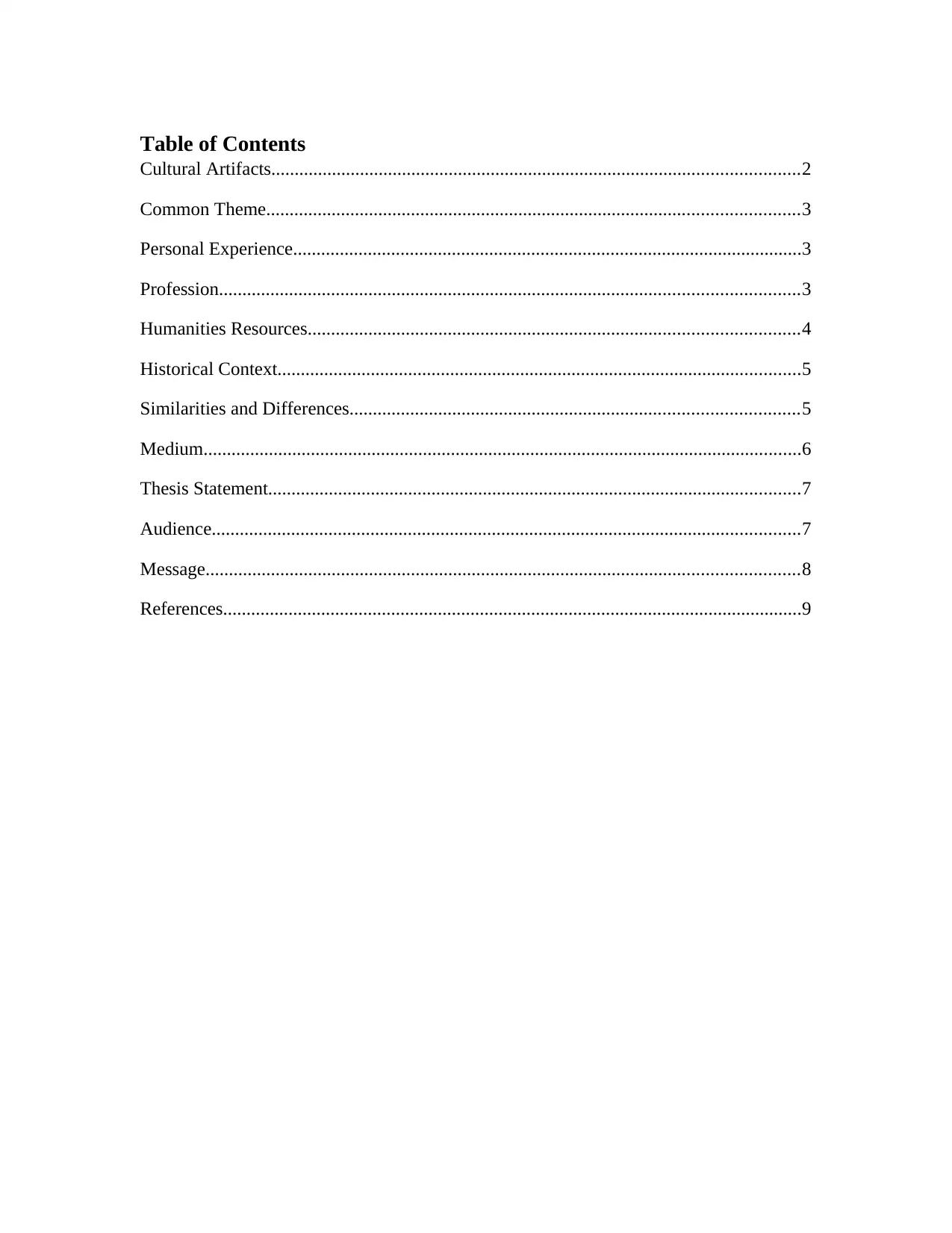
Table of Contents
Cultural Artifacts.................................................................................................................2
Common Theme..................................................................................................................3
Personal Experience.............................................................................................................3
Profession............................................................................................................................3
Humanities Resources.........................................................................................................4
Historical Context................................................................................................................5
Similarities and Differences................................................................................................5
Medium................................................................................................................................6
Thesis Statement..................................................................................................................7
Audience..............................................................................................................................7
Message...............................................................................................................................8
References............................................................................................................................9
Cultural Artifacts.................................................................................................................2
Common Theme..................................................................................................................3
Personal Experience.............................................................................................................3
Profession............................................................................................................................3
Humanities Resources.........................................................................................................4
Historical Context................................................................................................................5
Similarities and Differences................................................................................................5
Medium................................................................................................................................6
Thesis Statement..................................................................................................................7
Audience..............................................................................................................................7
Message...............................................................................................................................8
References............................................................................................................................9

Exploration Document
Tania Farhat
HUM200
Cultural Artifacts
In almost every case, the historical facts of diverse communities comprise of the
experiences of various groups. To represent the history, various depictions and voices in
the form of Art and Music is essential. Compilation of heritage and history of a particular
place may be painful, political and contentious. Incorporation of art and music in the
cultural activities may help the planners to share their experiences, stories, give
opportunities to the community residents for participating actively in process of planning
and visioning, foster the celebration and tolerance of identity, improve the aggregate
understanding of heritage and history of place of community, establish the relationship
between diverse group of individuals and participate in the learning process.
"Composition" is the act or practice of creating a song, an instrumental music piece, a
work with both singing and instruments, or another type of music (Tan, 2000). In many
cultures, including Western classical music, the act of composing also includes the
creation of music notation, such as a sheet music "score", which is then performed by the
composer or by other singers or musicians. In popular music and traditional music, the
act of composing, which is typically called songwriting, may involve the creation of a
basic outline of the song, called the lead sheet, which sets out the melody, lyrics and
chord progression. In classical music, the composer typically orchestrates her own
compositions, but in musical theatre and in pop music, songwriters may hire an arranger
to do the orchestration. In some cases, a songwriter may not use notation at all, and
Tania Farhat
HUM200
Cultural Artifacts
In almost every case, the historical facts of diverse communities comprise of the
experiences of various groups. To represent the history, various depictions and voices in
the form of Art and Music is essential. Compilation of heritage and history of a particular
place may be painful, political and contentious. Incorporation of art and music in the
cultural activities may help the planners to share their experiences, stories, give
opportunities to the community residents for participating actively in process of planning
and visioning, foster the celebration and tolerance of identity, improve the aggregate
understanding of heritage and history of place of community, establish the relationship
between diverse group of individuals and participate in the learning process.
"Composition" is the act or practice of creating a song, an instrumental music piece, a
work with both singing and instruments, or another type of music (Tan, 2000). In many
cultures, including Western classical music, the act of composing also includes the
creation of music notation, such as a sheet music "score", which is then performed by the
composer or by other singers or musicians. In popular music and traditional music, the
act of composing, which is typically called songwriting, may involve the creation of a
basic outline of the song, called the lead sheet, which sets out the melody, lyrics and
chord progression. In classical music, the composer typically orchestrates her own
compositions, but in musical theatre and in pop music, songwriters may hire an arranger
to do the orchestration. In some cases, a songwriter may not use notation at all, and
⊘ This is a preview!⊘
Do you want full access?
Subscribe today to unlock all pages.

Trusted by 1+ million students worldwide
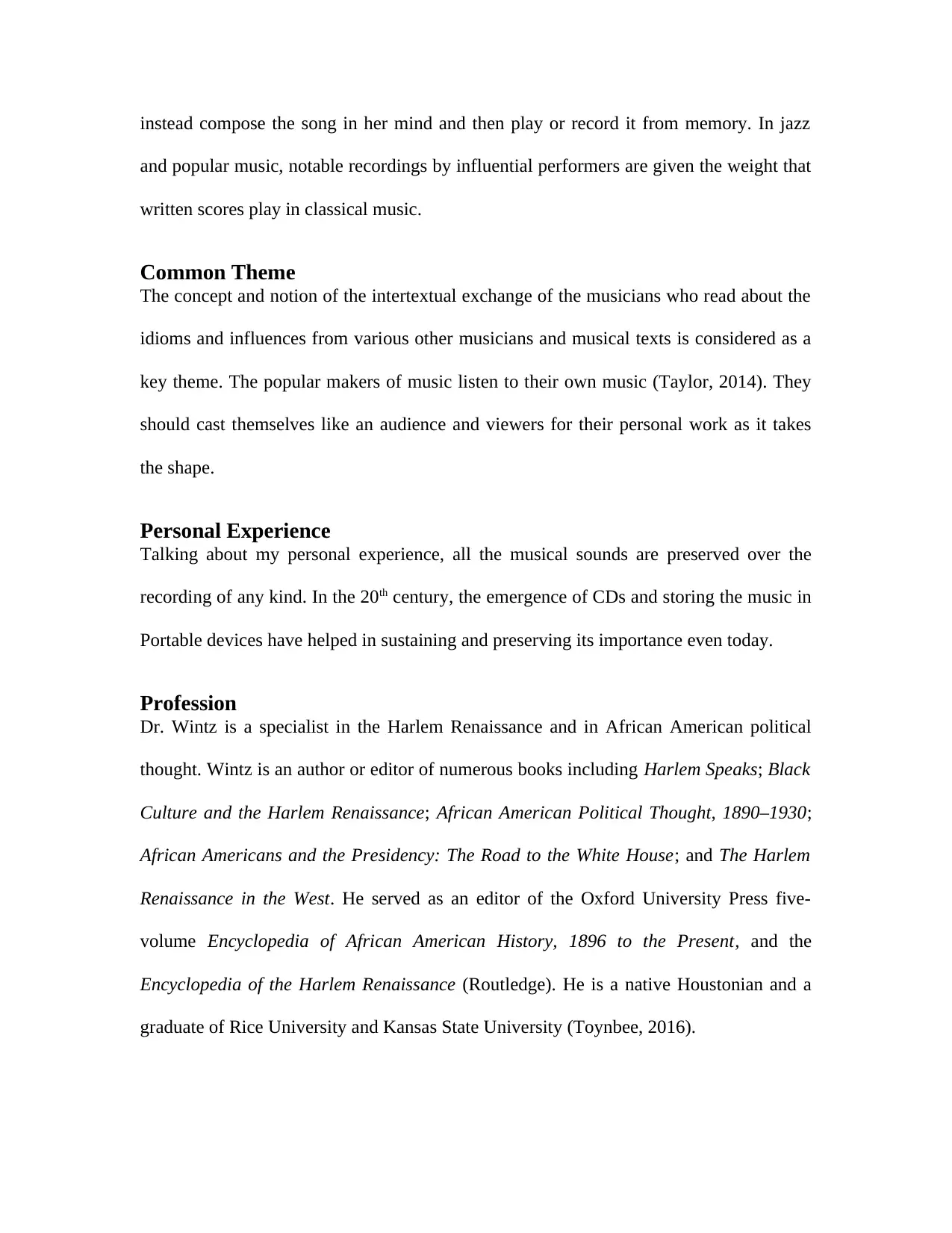
instead compose the song in her mind and then play or record it from memory. In jazz
and popular music, notable recordings by influential performers are given the weight that
written scores play in classical music.
Common Theme
The concept and notion of the intertextual exchange of the musicians who read about the
idioms and influences from various other musicians and musical texts is considered as a
key theme. The popular makers of music listen to their own music (Taylor, 2014). They
should cast themselves like an audience and viewers for their personal work as it takes
the shape.
Personal Experience
Talking about my personal experience, all the musical sounds are preserved over the
recording of any kind. In the 20th century, the emergence of CDs and storing the music in
Portable devices have helped in sustaining and preserving its importance even today.
Profession
Dr. Wintz is a specialist in the Harlem Renaissance and in African American political
thought. Wintz is an author or editor of numerous books including Harlem Speaks; Black
Culture and the Harlem Renaissance; African American Political Thought, 1890–1930;
African Americans and the Presidency: The Road to the White House; and The Harlem
Renaissance in the West. He served as an editor of the Oxford University Press five-
volume Encyclopedia of African American History, 1896 to the Present, and the
Encyclopedia of the Harlem Renaissance (Routledge). He is a native Houstonian and a
graduate of Rice University and Kansas State University (Toynbee, 2016).
and popular music, notable recordings by influential performers are given the weight that
written scores play in classical music.
Common Theme
The concept and notion of the intertextual exchange of the musicians who read about the
idioms and influences from various other musicians and musical texts is considered as a
key theme. The popular makers of music listen to their own music (Taylor, 2014). They
should cast themselves like an audience and viewers for their personal work as it takes
the shape.
Personal Experience
Talking about my personal experience, all the musical sounds are preserved over the
recording of any kind. In the 20th century, the emergence of CDs and storing the music in
Portable devices have helped in sustaining and preserving its importance even today.
Profession
Dr. Wintz is a specialist in the Harlem Renaissance and in African American political
thought. Wintz is an author or editor of numerous books including Harlem Speaks; Black
Culture and the Harlem Renaissance; African American Political Thought, 1890–1930;
African Americans and the Presidency: The Road to the White House; and The Harlem
Renaissance in the West. He served as an editor of the Oxford University Press five-
volume Encyclopedia of African American History, 1896 to the Present, and the
Encyclopedia of the Harlem Renaissance (Routledge). He is a native Houstonian and a
graduate of Rice University and Kansas State University (Toynbee, 2016).
Paraphrase This Document
Need a fresh take? Get an instant paraphrase of this document with our AI Paraphraser
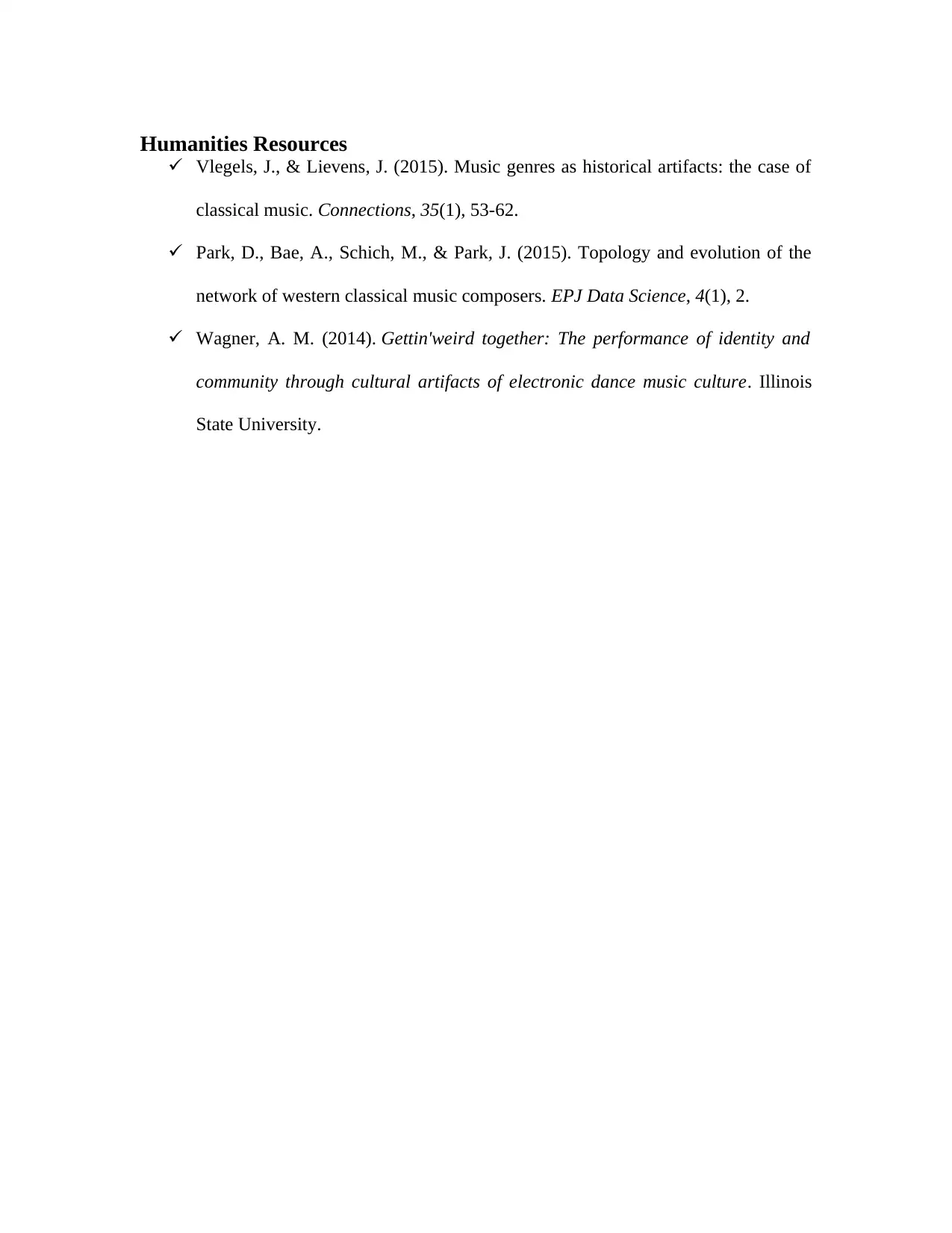
Humanities Resources
Vlegels, J., & Lievens, J. (2015). Music genres as historical artifacts: the case of
classical music. Connections, 35(1), 53-62.
Park, D., Bae, A., Schich, M., & Park, J. (2015). Topology and evolution of the
network of western classical music composers. EPJ Data Science, 4(1), 2.
Wagner, A. M. (2014). Gettin'weird together: The performance of identity and
community through cultural artifacts of electronic dance music culture. Illinois
State University.
Vlegels, J., & Lievens, J. (2015). Music genres as historical artifacts: the case of
classical music. Connections, 35(1), 53-62.
Park, D., Bae, A., Schich, M., & Park, J. (2015). Topology and evolution of the
network of western classical music composers. EPJ Data Science, 4(1), 2.
Wagner, A. M. (2014). Gettin'weird together: The performance of identity and
community through cultural artifacts of electronic dance music culture. Illinois
State University.
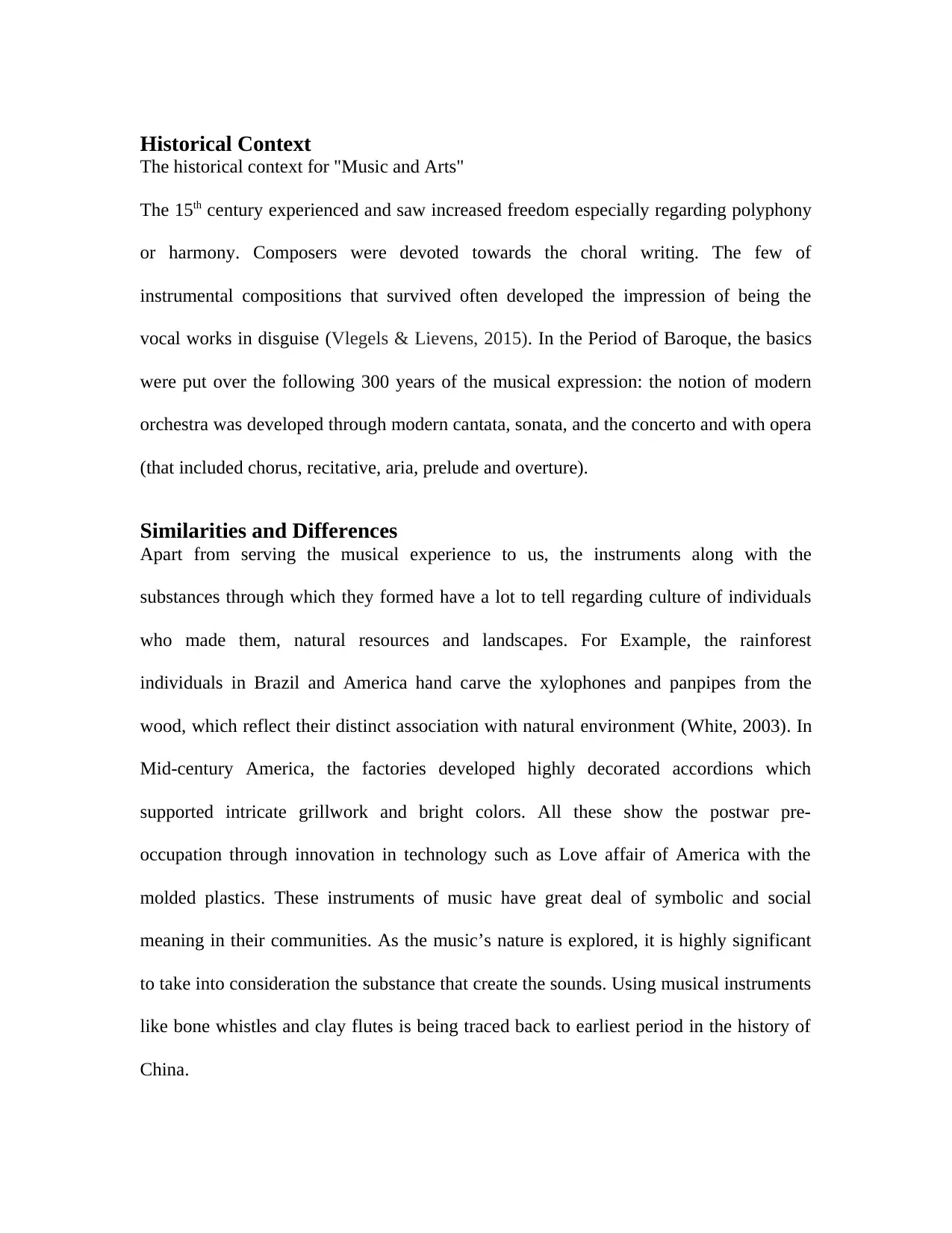
Historical Context
The historical context for "Music and Arts"
The 15th century experienced and saw increased freedom especially regarding polyphony
or harmony. Composers were devoted towards the choral writing. The few of
instrumental compositions that survived often developed the impression of being the
vocal works in disguise (Vlegels & Lievens, 2015). In the Period of Baroque, the basics
were put over the following 300 years of the musical expression: the notion of modern
orchestra was developed through modern cantata, sonata, and the concerto and with opera
(that included chorus, recitative, aria, prelude and overture).
Similarities and Differences
Apart from serving the musical experience to us, the instruments along with the
substances through which they formed have a lot to tell regarding culture of individuals
who made them, natural resources and landscapes. For Example, the rainforest
individuals in Brazil and America hand carve the xylophones and panpipes from the
wood, which reflect their distinct association with natural environment (White, 2003). In
Mid-century America, the factories developed highly decorated accordions which
supported intricate grillwork and bright colors. All these show the postwar pre-
occupation through innovation in technology such as Love affair of America with the
molded plastics. These instruments of music have great deal of symbolic and social
meaning in their communities. As the music’s nature is explored, it is highly significant
to take into consideration the substance that create the sounds. Using musical instruments
like bone whistles and clay flutes is being traced back to earliest period in the history of
China.
The historical context for "Music and Arts"
The 15th century experienced and saw increased freedom especially regarding polyphony
or harmony. Composers were devoted towards the choral writing. The few of
instrumental compositions that survived often developed the impression of being the
vocal works in disguise (Vlegels & Lievens, 2015). In the Period of Baroque, the basics
were put over the following 300 years of the musical expression: the notion of modern
orchestra was developed through modern cantata, sonata, and the concerto and with opera
(that included chorus, recitative, aria, prelude and overture).
Similarities and Differences
Apart from serving the musical experience to us, the instruments along with the
substances through which they formed have a lot to tell regarding culture of individuals
who made them, natural resources and landscapes. For Example, the rainforest
individuals in Brazil and America hand carve the xylophones and panpipes from the
wood, which reflect their distinct association with natural environment (White, 2003). In
Mid-century America, the factories developed highly decorated accordions which
supported intricate grillwork and bright colors. All these show the postwar pre-
occupation through innovation in technology such as Love affair of America with the
molded plastics. These instruments of music have great deal of symbolic and social
meaning in their communities. As the music’s nature is explored, it is highly significant
to take into consideration the substance that create the sounds. Using musical instruments
like bone whistles and clay flutes is being traced back to earliest period in the history of
China.
⊘ This is a preview!⊘
Do you want full access?
Subscribe today to unlock all pages.

Trusted by 1+ million students worldwide

Paraphrase This Document
Need a fresh take? Get an instant paraphrase of this document with our AI Paraphraser
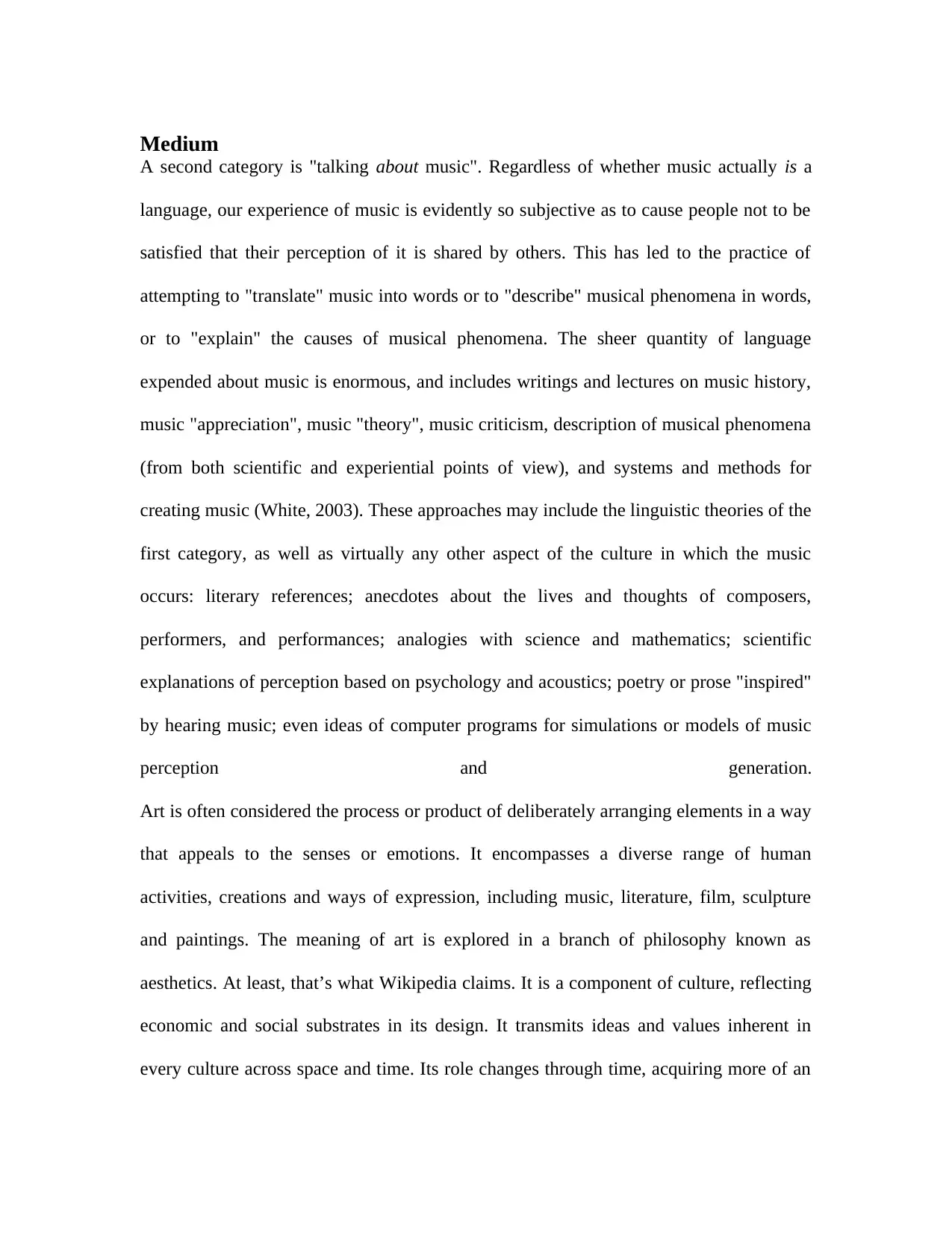
Medium
A second category is "talking about music". Regardless of whether music actually is a
language, our experience of music is evidently so subjective as to cause people not to be
satisfied that their perception of it is shared by others. This has led to the practice of
attempting to "translate" music into words or to "describe" musical phenomena in words,
or to "explain" the causes of musical phenomena. The sheer quantity of language
expended about music is enormous, and includes writings and lectures on music history,
music "appreciation", music "theory", music criticism, description of musical phenomena
(from both scientific and experiential points of view), and systems and methods for
creating music (White, 2003). These approaches may include the linguistic theories of the
first category, as well as virtually any other aspect of the culture in which the music
occurs: literary references; anecdotes about the lives and thoughts of composers,
performers, and performances; analogies with science and mathematics; scientific
explanations of perception based on psychology and acoustics; poetry or prose "inspired"
by hearing music; even ideas of computer programs for simulations or models of music
perception and generation.
Art is often considered the process or product of deliberately arranging elements in a way
that appeals to the senses or emotions. It encompasses a diverse range of human
activities, creations and ways of expression, including music, literature, film, sculpture
and paintings. The meaning of art is explored in a branch of philosophy known as
aesthetics. At least, that’s what Wikipedia claims. It is a component of culture, reflecting
economic and social substrates in its design. It transmits ideas and values inherent in
every culture across space and time. Its role changes through time, acquiring more of an
A second category is "talking about music". Regardless of whether music actually is a
language, our experience of music is evidently so subjective as to cause people not to be
satisfied that their perception of it is shared by others. This has led to the practice of
attempting to "translate" music into words or to "describe" musical phenomena in words,
or to "explain" the causes of musical phenomena. The sheer quantity of language
expended about music is enormous, and includes writings and lectures on music history,
music "appreciation", music "theory", music criticism, description of musical phenomena
(from both scientific and experiential points of view), and systems and methods for
creating music (White, 2003). These approaches may include the linguistic theories of the
first category, as well as virtually any other aspect of the culture in which the music
occurs: literary references; anecdotes about the lives and thoughts of composers,
performers, and performances; analogies with science and mathematics; scientific
explanations of perception based on psychology and acoustics; poetry or prose "inspired"
by hearing music; even ideas of computer programs for simulations or models of music
perception and generation.
Art is often considered the process or product of deliberately arranging elements in a way
that appeals to the senses or emotions. It encompasses a diverse range of human
activities, creations and ways of expression, including music, literature, film, sculpture
and paintings. The meaning of art is explored in a branch of philosophy known as
aesthetics. At least, that’s what Wikipedia claims. It is a component of culture, reflecting
economic and social substrates in its design. It transmits ideas and values inherent in
every culture across space and time. Its role changes through time, acquiring more of an
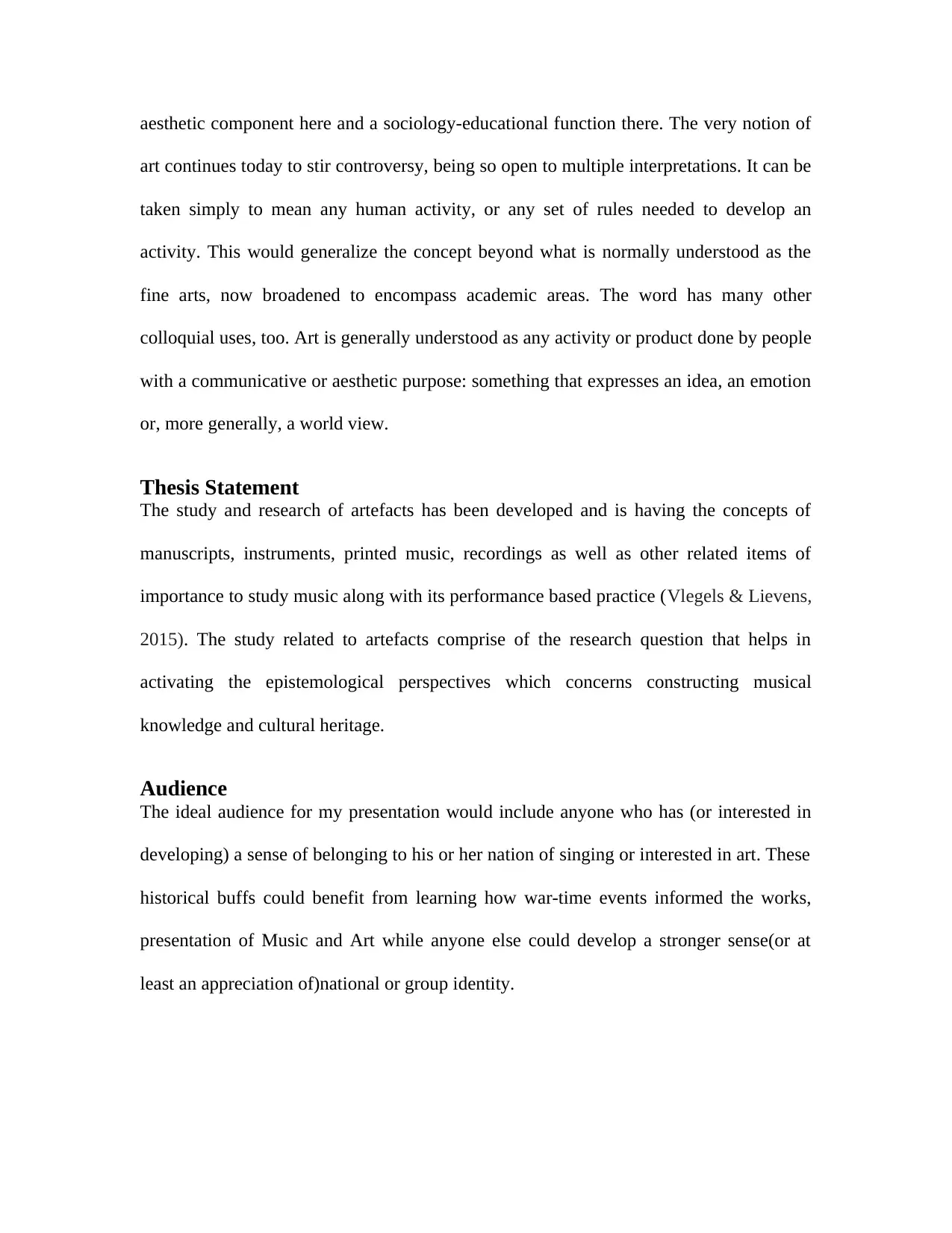
aesthetic component here and a sociology-educational function there. The very notion of
art continues today to stir controversy, being so open to multiple interpretations. It can be
taken simply to mean any human activity, or any set of rules needed to develop an
activity. This would generalize the concept beyond what is normally understood as the
fine arts, now broadened to encompass academic areas. The word has many other
colloquial uses, too. Art is generally understood as any activity or product done by people
with a communicative or aesthetic purpose: something that expresses an idea, an emotion
or, more generally, a world view.
Thesis Statement
The study and research of artefacts has been developed and is having the concepts of
manuscripts, instruments, printed music, recordings as well as other related items of
importance to study music along with its performance based practice (Vlegels & Lievens,
2015). The study related to artefacts comprise of the research question that helps in
activating the epistemological perspectives which concerns constructing musical
knowledge and cultural heritage.
Audience
The ideal audience for my presentation would include anyone who has (or interested in
developing) a sense of belonging to his or her nation of singing or interested in art. These
historical buffs could benefit from learning how war-time events informed the works,
presentation of Music and Art while anyone else could develop a stronger sense(or at
least an appreciation of)national or group identity.
art continues today to stir controversy, being so open to multiple interpretations. It can be
taken simply to mean any human activity, or any set of rules needed to develop an
activity. This would generalize the concept beyond what is normally understood as the
fine arts, now broadened to encompass academic areas. The word has many other
colloquial uses, too. Art is generally understood as any activity or product done by people
with a communicative or aesthetic purpose: something that expresses an idea, an emotion
or, more generally, a world view.
Thesis Statement
The study and research of artefacts has been developed and is having the concepts of
manuscripts, instruments, printed music, recordings as well as other related items of
importance to study music along with its performance based practice (Vlegels & Lievens,
2015). The study related to artefacts comprise of the research question that helps in
activating the epistemological perspectives which concerns constructing musical
knowledge and cultural heritage.
Audience
The ideal audience for my presentation would include anyone who has (or interested in
developing) a sense of belonging to his or her nation of singing or interested in art. These
historical buffs could benefit from learning how war-time events informed the works,
presentation of Music and Art while anyone else could develop a stronger sense(or at
least an appreciation of)national or group identity.
⊘ This is a preview!⊘
Do you want full access?
Subscribe today to unlock all pages.

Trusted by 1+ million students worldwide

Message
To tailor my presentation for my audience and make it more understandable and
relatable, I will try to connect the patriotism evident in my works to make positive the
examples of recent patriotic activity, such as the recent coming together of singing and
drawing pictures that explains what is happening and what kind of music is playing.
To tailor my presentation for my audience and make it more understandable and
relatable, I will try to connect the patriotism evident in my works to make positive the
examples of recent patriotic activity, such as the recent coming together of singing and
drawing pictures that explains what is happening and what kind of music is playing.
Paraphrase This Document
Need a fresh take? Get an instant paraphrase of this document with our AI Paraphraser
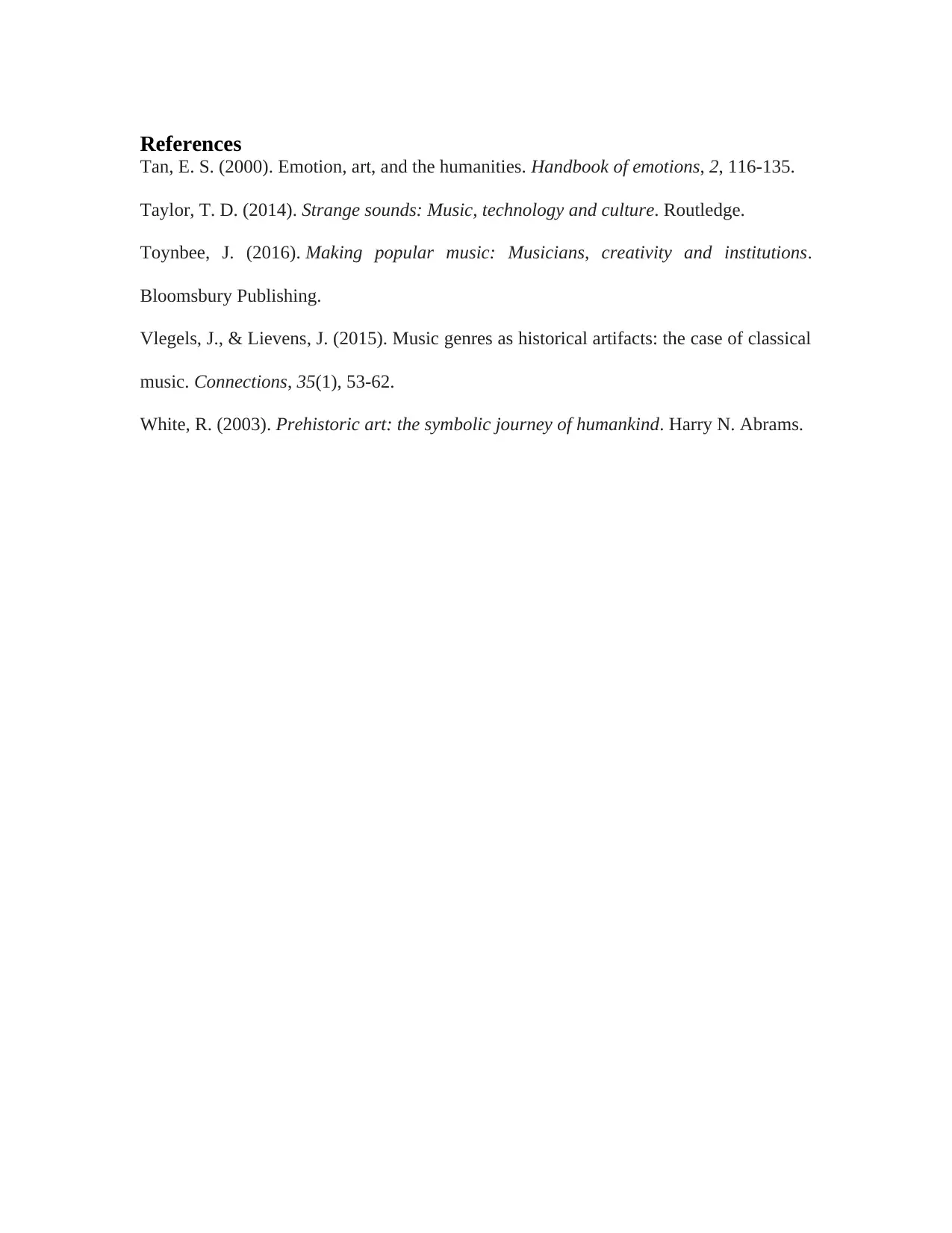
References
Tan, E. S. (2000). Emotion, art, and the humanities. Handbook of emotions, 2, 116-135.
Taylor, T. D. (2014). Strange sounds: Music, technology and culture. Routledge.
Toynbee, J. (2016). Making popular music: Musicians, creativity and institutions.
Bloomsbury Publishing.
Vlegels, J., & Lievens, J. (2015). Music genres as historical artifacts: the case of classical
music. Connections, 35(1), 53-62.
White, R. (2003). Prehistoric art: the symbolic journey of humankind. Harry N. Abrams.
Tan, E. S. (2000). Emotion, art, and the humanities. Handbook of emotions, 2, 116-135.
Taylor, T. D. (2014). Strange sounds: Music, technology and culture. Routledge.
Toynbee, J. (2016). Making popular music: Musicians, creativity and institutions.
Bloomsbury Publishing.
Vlegels, J., & Lievens, J. (2015). Music genres as historical artifacts: the case of classical
music. Connections, 35(1), 53-62.
White, R. (2003). Prehistoric art: the symbolic journey of humankind. Harry N. Abrams.
1 out of 11
Related Documents
Your All-in-One AI-Powered Toolkit for Academic Success.
+13062052269
info@desklib.com
Available 24*7 on WhatsApp / Email
![[object Object]](/_next/static/media/star-bottom.7253800d.svg)
Unlock your academic potential
Copyright © 2020–2025 A2Z Services. All Rights Reserved. Developed and managed by ZUCOL.




